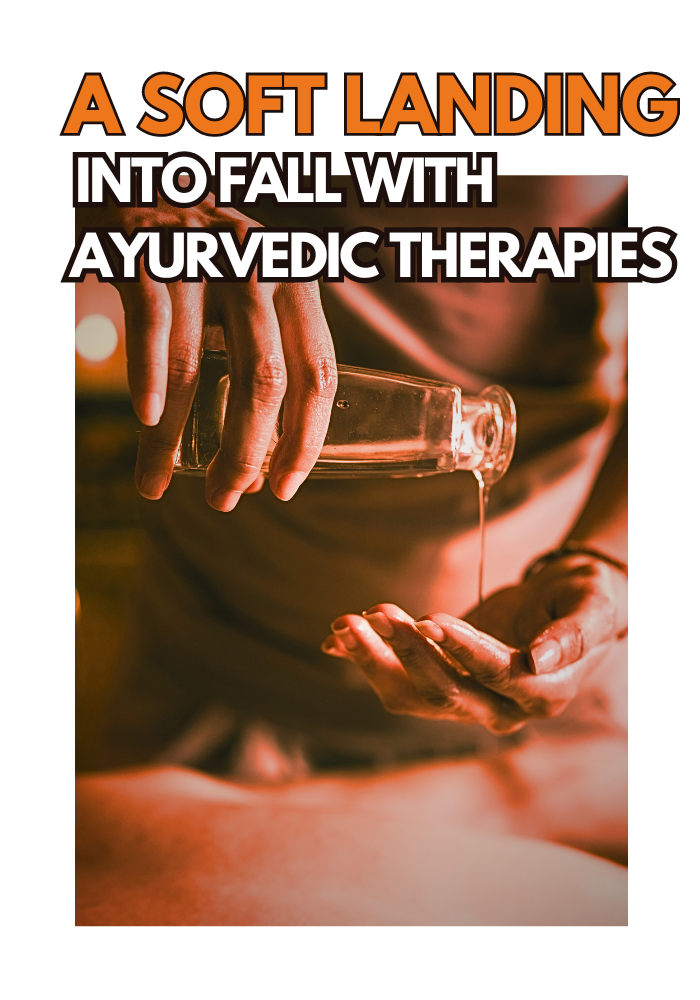Through Ayurveda, the traditional system of medicine that originated in India, we learn that fall (autumn) is considered a transitional season characterized by specific changes in the environment and the qualities of the doshas (fundamental energies) in the body.
Fall is marked by the following elemental shifts:
- Increased Vata Dosha: Vata dosha is composed of the elements of air and space. It is known for its qualities of coldness, dryness, lightness, mobility/restlessness, and irregularity.
- Cool and Dry Weather: Fall typically brings cooler temperatures and lower humidity levels, contributing to the dryness in the environment - and in the body.
- Variable Weather: Fall is a transitional season, and the weather can be quite changeable, with fluctuating temperatures and weather patterns.
- Falling Leaves: The shedding of leaves from trees is a visible sign of the season, reflecting the qualities of change and a movement towards dormancy.
Ayurvedic body therapies are recommended during the fall season for several reasons:
- Treating Vata: The warm oil featured in so many Ayurvedic body therapies helps to pacify excess Vata, providing grounding and stability.
- Hydrate and Nourish: As the weather becomes cooler and drier in the fall, the skin and tissues tend to become dry and may lose moisture. Ayurvedic warm oil massages and treatments help moisturize the skin and provide deep nourishment to the body tissues.
- Boost Immunity: Fall is a season when the body is more vulnerable to imbalances and illnesses. Ayurvedic oils often contain herbs and medicinals that have immune-boosting properties. The application of these oils combined with the immunity-boosting effects of relaxation can enhance the body's natural defense mechanisms.
- Relaxation and Stress Reduction: The warm oil massage is a deeply relaxing and soothing experience. It helps calm the mind, reduce stress, and promote a sense of well-being. In the fall, when Vata energy can lead to anxiety and restlessness, these therapies can be particularly beneficial.
- Promote Circulation: The massage techniques used in Ayurvedic body therapies help improve circulation, which can be important in the fall when cooler temperatures affect blood flow. Enhanced circulation can aid in the removal of toxins and support overall health.
- Joint Health: Fall can be a challenging season for those with joint issues as Vata dosha tends to accumulate in the joints, causing discomfort. Ayurvedic warm oil massages can help lubricate the joints, reduce stiffness, and alleviate joint-related issues.
Ayurvedic Body Therapies quickly calm and soothe deranged Vata in the mind and the body. Ayurvedic Massage (Abhyanga), The Blissful Mind (Shirodhara), and Herbalized Steam Sweats (Svedana) are particularly good for pacifying symptoms of imbalanced Vata in the body and mind. Additional, incorporating the following activities will bring more balance when managing Vata:
- Stay Warm: Dress warmly in layers to protect against the cold and windy fall weather. Keep your extremities, especially your head, neck, and ears, covered.
- Hydrate: To counteract the dryness of fall, drink warm herbal teas and plenty of water to stay hydrated. Avoid excessive consumption of cold or iced beverages.
- Moisturize: Use natural, nourishing moisturizer to keep your skin hydrated and prevent dryness.
- Follow a Vata-Pacifying Diet: Focus on warm, cooked, and slightly oily foods. Incorporate warming spices like ginger, cinnamon, and cardamom into your meals. Avoid raw, cold, and dry foods.
- Establish a Routine: Maintain a regular daily routine to provide stability and structure to your day. Vata benefits from consistency and predictability.
- Practice Self-Care: Engage in calming and grounding practices such as meditation, yoga, and deep breathing exercises to reduce stress and anxiety.
- Abhyanga (Oil Massage): Regular self-massage with warm, nourishing oils, such as sesame or almond oil, can help balance Vata by providing moisture and grounding.
- Ayurvedic Herbs: Consider Ayurvedic herbs and remedies that are specific for Vata imbalances. Consult an Ayurvedic practitioner for personalized recommendations.
To maintain health and balance during the fall season, focus on understanding Vata qualities and taking steps to offset them, particularly if you have a Vata constitution or are experiencing Vata imbalances. Ayurveda… There’s a Science to Living Well!

